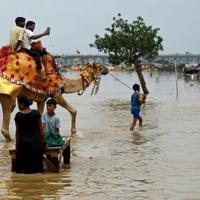Torrential storms impacting South Asia have resulted in the loss of hundreds of lives since June, as per official reports released on Tuesday. Flooding and landslides have caused extensive damage during the dangerous monsoon season.
Events linked to weather are frequent during the monsoon season from June to September, but experts suggest that climate change is escalating their occurrence and severity.
The reported fatalities include at least 250 in India, 171 in Nepal, and 178 in Pakistan, as per official statistics from each nation.
In India, following the longest heatwave on record earlier in the year, forceful rainstorms have led to widespread flooding and landslides, as mentioned by government meteorologists.
The oppressive heat experienced in May and June resulted in New Delhi reaching a temperature of 49.2C (120.5F), equaling the capital’s previous record high from 2022.
This heat has now given way to heavy rains.
The Indian weather department has issued alerts for “heavy rainfall” in a large portion of the southern and northeastern states this week.
Rescue operations are ongoing to locate two missing individuals following a tragic incident in the Una district of Himachal Pradesh state, where nine people drowned due to a surge of water.
Eye witnesses observed a car being swept away by the swollen river, resembling a toy in the swift, muddy current.
– Floods in deserts –
A significant number of fatalities have occurred in India this month alone, with 200 deaths reported in the southern state of Kerala last month due to landslides affecting villages and tea plantations.
In Nepal, 171 individuals have lost their lives since the onset of monsoon rains in mid-June, including 109 in landslides.
Additional fatalities in Nepal have been attributed to floods and lightning, as per the disaster response authority.
Ongoing search operations are in progress in Nepal’s Chitwan district for two buses swept away by a raging river on July 12, resulting in approximately 50 casualties.
In Pakistan, 178 deaths have been recorded since the onset of rains in July, with ninety-two children among the victims. The primary cause of death has been collapsing homes, as per the National Disaster Management Authority.
In the Khyber Pakhtunkhwa province in northwest Pakistan, mountain communities have been cautioned about the risk of glacial lake flooding as temperatures and humidity rise this week.
The monsoon rains spanning from June to September offer relief from the summer heat and are crucial for replenishing water resources.
These rains are also essential for agriculture, supporting the livelihoods of millions of farmers and ensuring food security for the nearly two billion people of South Asia.
Although India ranks as the world’s third-largest producer of greenhouse gases, it has pledged to transition to a net-zero emission economy by 2070, which is twenty years behind most industrialized nations.
Currently, India heavily relies on coal for power generation.
On the other hand, Pakistan contributes less than one percent to global greenhouse gases but remains highly vulnerable to the impacts of climate change.
In 2022, catastrophic flooding submerged a third of Pakistan, resulting in over 1,700 fatalities, displacing 33 million people, and destroying thousands of homes.
strs-pa-ash/pjm/ecl/sn





